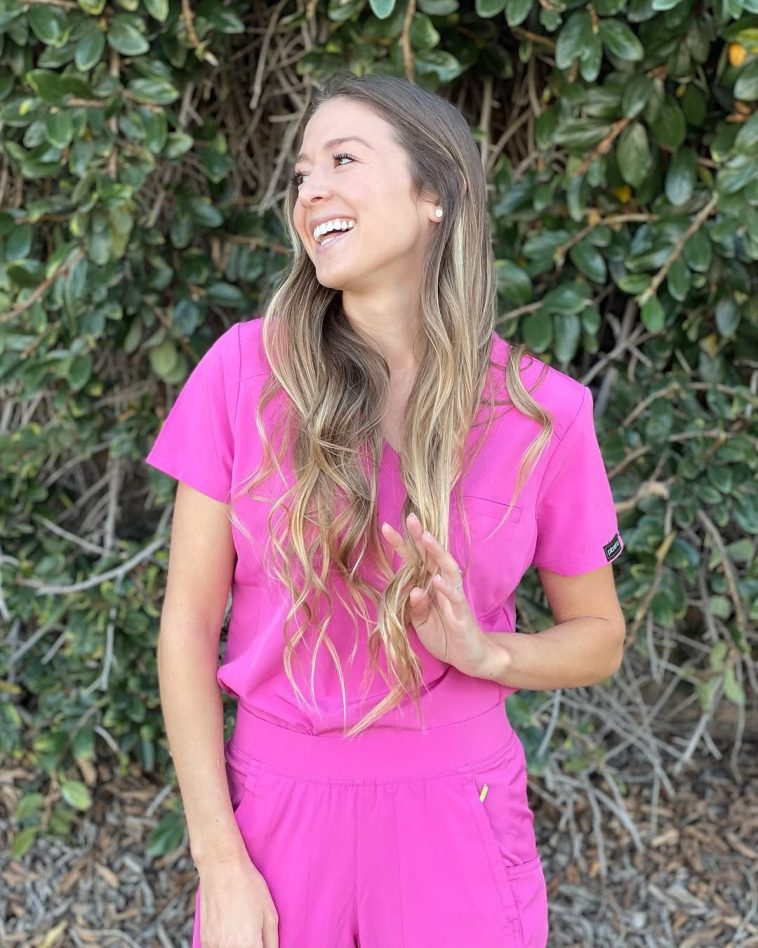One minute emergency room nurse Hailey Okula was sharing a “quick little laugh” with her husband over their newborn son and the next, she was gone.
That’s how LA firefighter Matthew Okula described his wife’s tragic passing on March 31, shortly after the 33-year-old nursing influencer delivered their son via C-section. “It just came upon me so quickly, unexpectedly,” Matthew said in an interview with Fox 11 Los Angeles on April 2.
Matthew says he’d just walked out of Hailey’s hospital room with baby Crew when his wife went into cardiac arrest due to a “very, very rare complication” called amniotic fluid embolism (AFE). According to the Cleveland Clinic, AFE is a “rare and life-threatening complication that occurs when a pregnant woman gets amniotic fluid into their bloodstream just before, during, or immediately after childbirth.”
“A minute later, the doctor lets me know that they”re doing CPR on her,” the firefighter recalled. “I’m making the decision, ‘Am I going to the ICU to be with my wife or am I staying with my newborn little baby?’ Not the decision we thought I would be making.”
Nurse Hailey’s passing has sparked a conversation about amniotic fluid embolism, which affects 1 in every 40,000 deliveries in the United State and is “very difficult to diagnose,” per the Cleveland Clinic. Here’s what you need to know.
Nurse Hailey was a beloved figure in the health care community.The death of Hailey Okula has understandably left a large community of nursing students, health care workers, and prospective parents reeling. Known online as “Nurse Hailey,” the ER nurse had amassed over 680,000 followers across TikTok and Instagram for sharing tips and resources for health care workers and nursing grads on her social media accounts and through her business, RN New Grads.
“Hailey poured her soul into her career as a nurse and her passion for teaching others through her business, RN New Grads,” Matthew wrote on Instagram while sharing the news of her passing on April 1. “She was so proud of it and was dedicated to creating something meaningful, not just for herself, but for the nursing community she loved so much. She dreamed of helping new nurses thrive while also being present for our sweet Crew, building a life and legacy she was so proud of.”
Over the years the nursing influencer also shared candid look at her infertility struggles and pregnancy journey. “She wanted to be a mom so incredibly bad,” Matt told Fox 11 Los Angeles.
What is amniotic fluid?Amniotic fluid is the liquid that surrounds a fetus in utero prior to birth. Per the Cleveland Clinic, the fluid is “made of mostly water but also contains fetal cells and tissue.”
What causes an amniotic fluid embolism?According to the Cleveland Clinic, some patients experience an “extreme allergic reaction” when amniotic fluid mixes into the bloodstream, which is a “normal part of the birthing process.”
For “mostly unknown” reasons, an amniotic fluid embolism “can lead to heart and lung failure, which causes several complications due to a lack of oxygenated blood in your body.” In turn, this can lead to cardiac arrest or uncontrollable bleeding from the uterus or C-section incision.
The Cleveland Clinic reports that symptoms of AFE “develop suddenly and quickly” and can be difficult to diagnose due to their similarities with other pregnancy and birth complications.
Symptoms typically occur during childbirth or within 30 minutes of the delivery and can include shortness of breath or difficulty breathing, a sudden drop in blood pressure, pulmonary edema (fluid in your lungs), abnormal heart rate, chills, sudden anxiety or agitation, and bleeding from the uterus or C-section incision.
Lauren Demosthenes, an ob-gyn and senior medical director with Babyscripts, tells Glamour that symptoms are “dramatic and quick,” noting “patients may feel a sense of doom or anxiety.”
Amniotic fluid embolisms are extremely rare.AFEs are rare but have a high mortality rate, says Dr. Demosthenes, noting that “OB providers may never see one.”
She adds that although hard data is difficult to come by due to the condition’s unpredictability, 70% of AFEs occur during labor and the fatality rate is 50%, if not higher.
“Ultimately AFE leads to cardiopulmonary failure and DIC [disseminated intravascular coagulation], which is uncontrolled bleeding due to disruption of clotting factors,” Dr. Demosthenes says. “Response needs to be quick with a team of people who can provide CPR, respiratory support, blood products, and ICU care.”
She continues, “Risk cannot be lowered, but response and mortality can be improved by training and having the CPR, respiratory, anesthesia, neonatology teams, high-risk pregnancy teams, and ICU capability readily available. Of course, this may be difficult in rural hospitals or hospitals that are not equipped for this. But response needs to be immediate to reduce mortality.”
Many are sharing their stories after the death of Nurse Hailey.Many of Nurse Hailey’s followers have taken to the comments section of her social media feeds to share personal stories, messages of support, and resources related to AFE.
“I am so sorry for your loss. I had an amniotic embolism when I gave birth to my son via C-section. My heart stopped for 24 seconds,” one user replied to Matthew’s broadcast interview. “Thankfully, I made it out and I’m here today. I am praying for your family.”
Another responded, “I hope baby Crew grows up always knowing that his mother was such an amazing woman and always gave her heart to the community 🤍 I would not be the nurse I am today without her help and guidance! I praying for you and your family!!!🙏🏽”
However, some expectant parents find the viral nature of the story unhelpful.For some expectant parents, the “unpredictable” nature of AFE leads to severe anxiety. As the Cleveland Clinic notes, “Unfortunately, there’s no way to prevent amniotic fluid embolism. Health care providers are still unsure why AFE happens and what exactly causes this condition.”
The common advice shared in one Reddit thread about such fears: Stay off social media.
“It really does not help to read or hear about horror stories,” one user commented, adding, “Pregnancy is scary. I feel like this hasn’t been spoken about in the past, but more and more people are openly talking about the scary things that happen to them, and that’s great. It’s important people know the risks of pregnancy. But while you’re pregnant? It doesn’t help. As someone with medical anxiety I say live in a bubble until you bring that beautiful babe into the world.”
However, another wrote, “Hailey’s story is [heart] breaking. Maybe I’m in the minority here, but I like to be informed about any possibilities.”
Matthew Okula wrote about Nurse Hailey’s lasting impact in an Instagram tribute.Matthew captioned his local Fox interview with a message to his wife. “Through sheer dedication, you taught yourself everything—running a business, marketing, content creation, and so much more,” Matthew wrote, in part. “You created a community that trusted you, inspiring and educating millions of new grad nurses, RNs, doctors, and beyond. Your impact was immense, and I couldn’t be more proud.”
He continued, “Crew is going to grow up hearing about the incredible woman his mom was—how strong, brilliant, and fearless she was in everything she did. He’ll know that she was a true force, changing lives and leaving a legacy that will never be forgotten.”
To donate to the Amniotic Fluid Embolism foundation or the GoFundMe for Matthew Okula and his son, Crew, click here and here.





GIPHY App Key not set. Please check settings